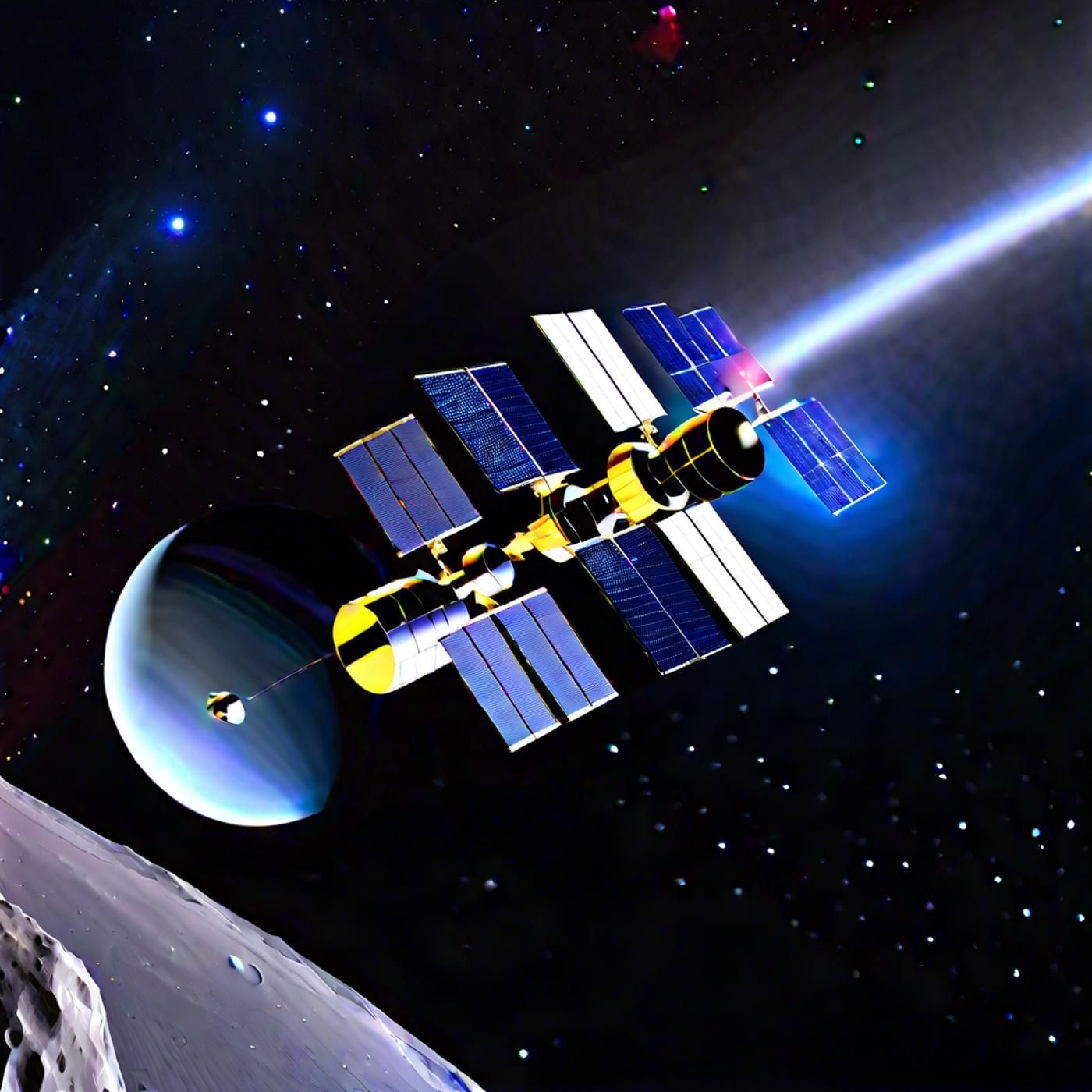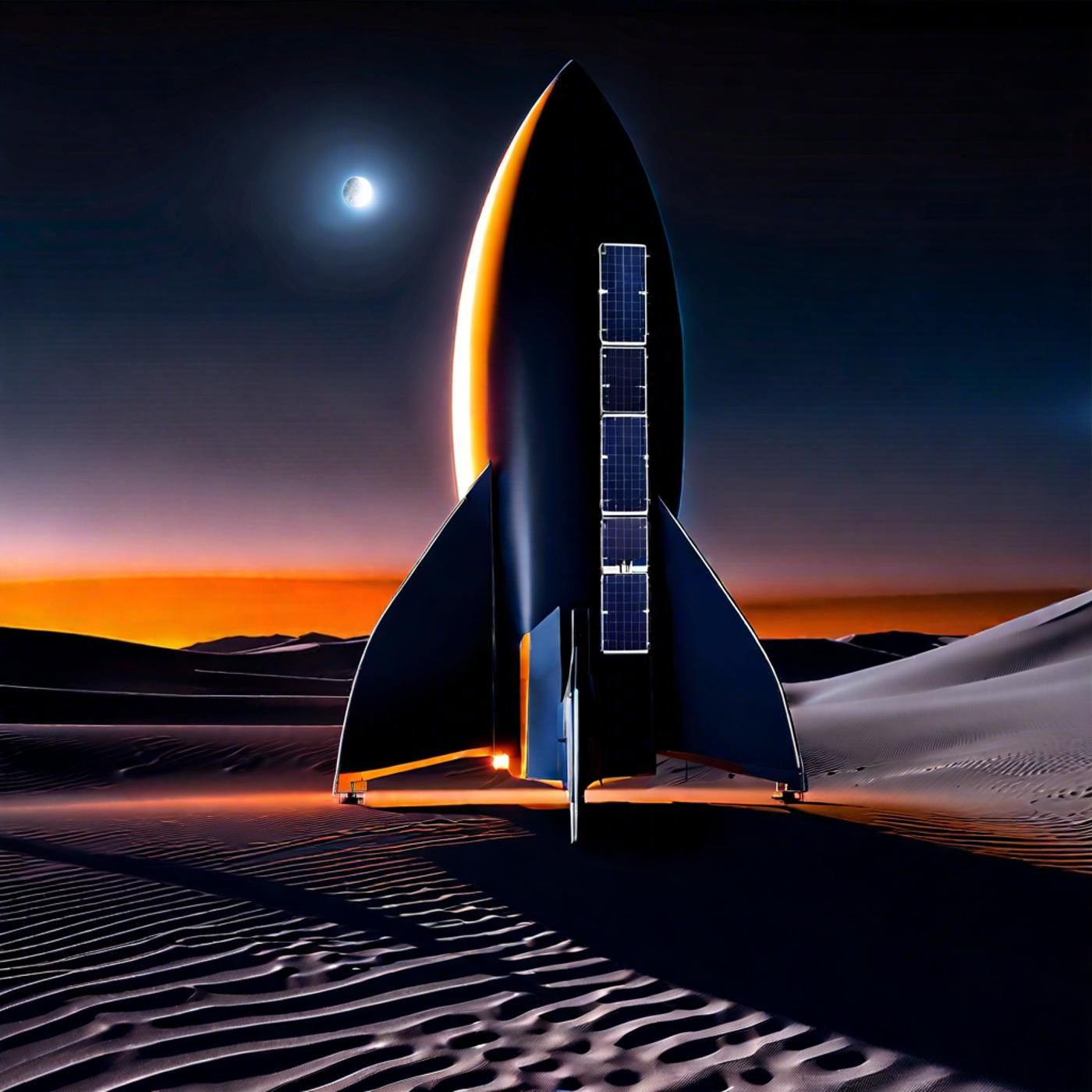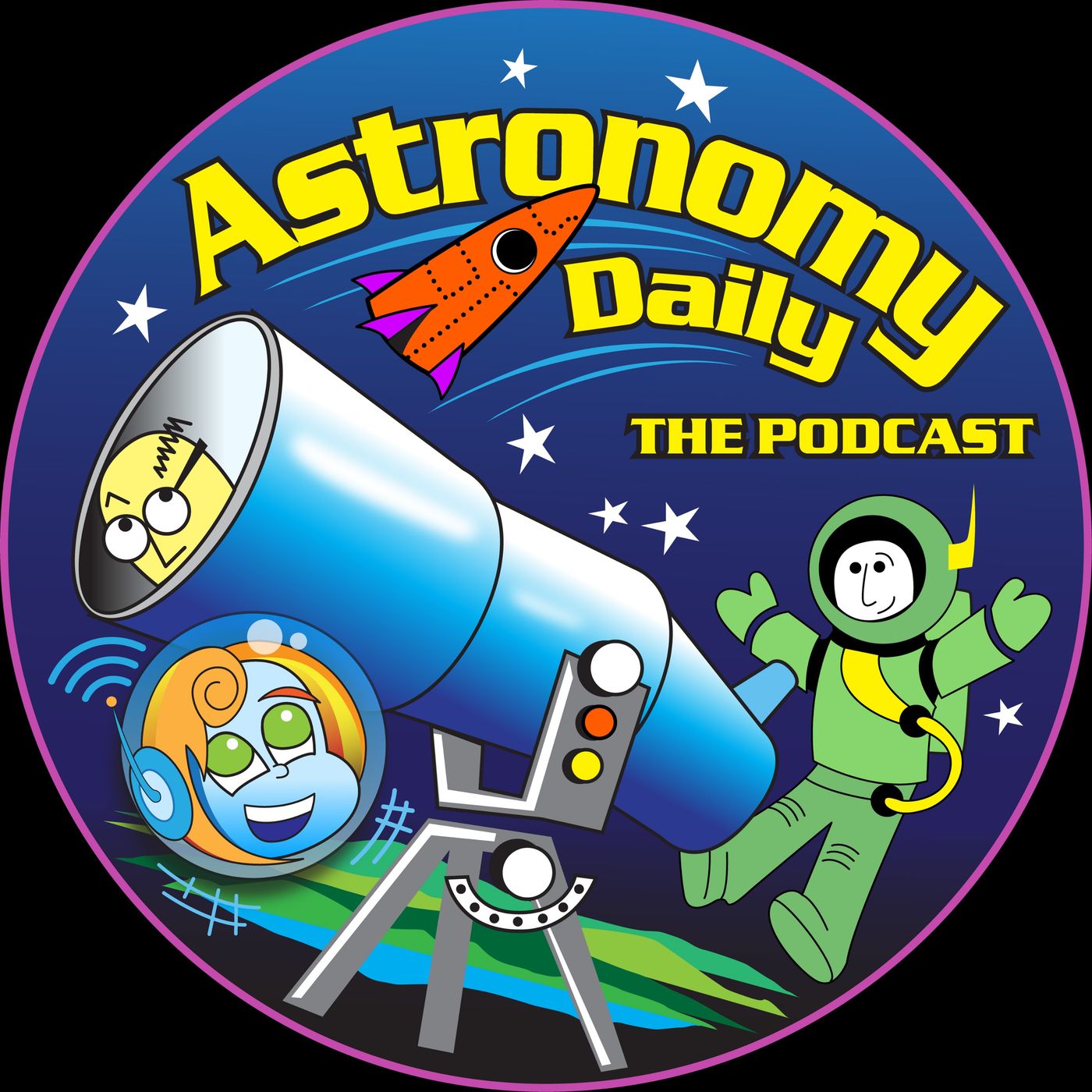S03E56: Starliner's Set Stage & Psyche's Stellar Progress: Pioneering the Space Frontier

Embark on a cosmic voyage with today's episode of Astronomy Daily - The Podcast, where your host, Anna, steers us through the latest developments in the universe. We're launching with NASA's new launch date for Boeing's Starliner crew flight test,...
Embark on a cosmic voyage with today's episode of Astronomy Daily - The Podcast, where your host, Anna, steers us through the latest developments in the universe. We're launching with NASA's new launch date for Boeing's Starliner crew flight test, aiming for a June 1 lift-off. Then, we'll glide over to NASA's Psyche mission as it sails towards a metal-rich asteroid using ion propulsion, passing its six-month health check with flying colors.We'll also dive into a paradigm-shifting study on the sun's magnetic fields, potentially redefining our understanding of solar phenomena. And don't miss our conversation with Dr. Tom Marshburn on the medical marvels being uncovered in the microgravity of space, promising a healthier future for us on Earth.Finally, we'll touch down at the Museum of Science and Industry in Chicago, where SpaceX's Dragon capsule has found a new home, inspiring the next generation of space explorers.
(00:00) This week's Astronomy Daily features some fascinating updates in space and astronomy
(00:51) NASA sets June 1 as earliest possible opportunity for Boeing's Starliner crew test
(05:36) New research suggests the sun's magnetic fields originate from much shallower processes
(08:29) Research into how space affects astronauts is driving medical breakthroughs on Earth
For an astronomical experience, visit our website at astronomydaily.io for the latest news, sign up for our free newsletter, and check out exclusive sponsor deals. Connect with us on X (@AstroDailyPod) for engaging discussions with fellow space aficionados.This is Anna, reminding you to keep your gaze fixed on the heavens. Until our next stellar episode, let the cosmos ignite your curiosity and wonder. Clear skies and cosmic discoveries to all!
Become a supporter of this podcast: https://www.spreaker.com/podcast/astronomy-daily-the-podcast--5648921/support.
www.astronomydaily.io
www.bitesz.com
Sponsor
www.bitesz.com/nordpass
Today's Astronomy Daily features some fascinating updates in space and astronomy
Anna: Welcome to another episode of Astronomy Daily. I'm your host, Anna, and I'm thrilled to have you join us. In today's episode. We'll delve into some fascinating updates in the world of space and astronomy. We'll start by discussing NASA and Boeing's recent announcement of a new target date for the much anticipated launch of the Starliners crew flight test. Next, well provide an exciting update on NASA's psyche mission, which is currently on its journey to a metal rich asteroid. We'll also explore some groundbreaking insights into the sun's magnetic fields that could revolutionize our understanding of solar phenomena. Finally, we'll highlight some of the remarkable medical m advancements being achieved through research conducted in space. So sit back, relax, and let's embark on this cosmic journey together.
NASA sets June 1 as earliest possible opportunity for Boeing's Starliner crew test
Execution the Astronomy Daily podcast NASA has announced a new target date for Boeing's Starliner crew flight test, setting June 1 as the earliest possible opportunity for liftoff. This significant milestone comes after resolving several technical issues that previously delayed the mission. Initially scheduled for earlier this month, the launch was postponed due to an oxygen pressure release valve malfunction in United Launch Alliance's Atlas V rocket and a helium leak in the propulsion system of the Starliner spacecraft. Engineers worked diligently over the past weeks to address these problems, including replacing a faulty valve and performing extensive checks on the spacecraft's systems. Despite the intricate challenges, the joint efforts by NASA, Boeing, and ULA have ensured that all systems are now ready for the mission. This crew flight test carrying astronauts Butch Wilmore and SUNY Williams is crucial for demonstrating the spacecraft's capabilities and paving the way for future crew rotations. Its a vital step toward certifying Starliner for regular missions to the International Space Station, complementing SpaceXs operational Dragon capsule. The success of this mission would solidify Starliners role in NASAS commercial crew program. Aiming for the first full crew rotation mission, Starliner one anticipated for spring 2025, NASAS Psyche mission has recently achieved a significant milestone, passing its six month checkup with a clean bill of health. This mission aims to reach the metal rich asteroid psyche, believed to be the exposed core of an early planetesimal, which could offer invaluable insights into the formation of rocky planets, including Earth. The spacecraft is employing futuristic ion propulsion technology to traverse the vast expanse of space. These electric thrusters, which emit a mesmerizing blue glow, have been operating almost nonstop. This method, which involves expelling ionized xenon, is not only energy efficient, but also propels the craft with gentle yet effective force launched from NASA's Kennedy Space center in October 2023, Psyche has already journeyed beyond Mars and is now in what mission planners describe as full cruise mode. The solar electric propulsion system has helped the spacecraft cover more than 190 million mile, 300 million, achieve a remarkable speed of 23 miles/second 37 km/second relative to Earth. The mission's objective is to arrive at asteroid psyche by 2029, where it will spend approximately two years in orbit collecting vital scientific data. This research is expected to enhance our understanding of the metallic cores that lie at the heart of terrestrial planets. The craft's six month checkup has shown that all systems are functioning smoothly. The magnetometer, gamma ray, and neutron spectrometer have all been performing well, even detecting solar events. The onboard cameras have also captured their first images, confirming the success of the initial phase of the mission. With the spacecraft slated for a close flyby of Mars in 2026 and plans to maximize the mission's potential, NASA's psyche is not just charting a, course through space, but also through the annals of planetary science. Airbus has been contracted by the European Space agency, or ESA, to build the vigil mission, a significant step forward in space weather forecasting. The vigil mission will provide critical data and predictions regarding space weather events that can impact everything from satellite operations to ground based technologies. By monitoring solar activities and cosmic phenomena, the mission aims to protect our increasingly vital space assets by giving advanced warnings of potential disruptions. This initiative underscores the growing recognition of space weather's influence on our daily lives and the paramount importance of safeguarding our technological infrastructure. In a momentous step towards safeguarding our space environment, twelve countries have come together to sign the zero debris charter. This landmark initiative aims to tackle the growing problem of space debris, which poses significant risks to operational satellites and spacecraft. By committing to stringent mitigation measures and debris removal strategies, these nations are working to ensure that our orbital pathways remain safe and navigable for future space missions. This collaborative effort underscores the global recognition of space debris as a critical issue and marks a proactive approach in maintaining a sustainable space environment.
New research suggests the sun's magnetic fields originate from much shallower processes
In a groundbreaking study published recently in Nature, scientists from MIT and the University of Edinburgh present controversial findings that challenge long held beliefs about the sun's magnetic fields. Traditionally, it was thought that these magnetic fields were generated deep within the sun, courtesy of a process known as dynamo action. However, this new research suggests that the sun's magnetic fields may actually originate from much shallower processes near the sun's surface. The study offers detailed models simulating disturbances in the plasma flow within the upper five to 10% of the sun, and these simulations demonstrate that surface level perturbations can generate magnetic patterns strikingly similar to those observed by astronomers. This is in contrast to earlier models, which postulated that deeper layers were responsible but yielded less accurate depictions of solar activities such as sunspots and flares. These findings have enormous implications for our understanding of the sun. If the magnetic fields are indeed created in these shallower layers, it could revolutionize the way we predict and study space weather phenomena. Sunspots, for instance, are cooler regions on the sun's surface associated with intense magnetic activity, appearing dark against the brighter solar backdrop. They have been observed to follow an eleven year cycle, forming predominantly around the equator rather than the poles. The new research aligns with these observations, suggesting that sunspots and solar flares may be easier to forecast with this refined understanding of magnetic field generation. Moreover, this discovery could significantly improve predictions of geomagnetic storms, which can disturb satellite operations and disrupt telecommunications on Earth. The researchers surmise that by focusing on the outer layers of the sun, where plasma flows more dynamically, we can develop more accurate models to anticipate such solar events. This enhanced forecasting capability would be a substantial leap forward in our efforts to protect technological systems reliant on satellite communications and navigation. In summary, while these findings may stir debate within the scientific community, they unquestionably open new avenues for studying the intricate dynamics of our closest star. Promising advancements in both theoretical astrophysics and practical space weather forecasting. The astronomy Daily podcast in the realm of medical research, the microgravity environment of space offers unparalleled opportunities for groundbreaking advancements. Today, we'll dig into a fascinating conversation with doctor Tom Marshburn, veteran NASA astronaut and now chief medical officer for Sierra Space, about the extraordinary medical research being conducted in low Earth orbit and its transformative potential for healthcare on earth.
Research into how space affects astronauts is driving medical breakthroughs on Earth
Doctor Marshburn emphasized how the unique conditions of microgravity can alter organisms, from human bacteria and viruses to DNA, and even change the way cells function. These alterations enable astronauts to carry out experiments that wouldn't be possible elsewhere, providing crucial insights into health issues on Earth. The research not only focuses on how space affects astronaut health, but also seeks to advance treatments for conditions like osteoporosis and the impacts of aging. For example, microgravity accelerates aging processes in astronauts such as muscle atrophy and cardiovascular weakness, which offers a unique model to study these conditions in a fraction of the time it would take on Earth. The rapid onset of these conditions in space allows scientists to observe and understand the mechanisms at a cellular level facilitating the development of more effective treatments and therapies. Doctor Marshburn also shared how diagnostic techniques developed for space missions are making their way back to improve medical care on earth without x ray machines. In space, astronauts use ultrasound for diagnostic imaging. These studies have led to innovations like the focused assessment with sonography and trauma fast exam, which is now a critical tool in emergency rooms worldwide for quickly detecting and treating conditions like pneumothorax. Further space experiments have paved the way for creating advanced medical technologies. For instance, capillary flow experiments in space have enabled the miniaturization of laboratory equipment, advancing point of care diagnostics that can be used in remote or resource limited settings. This innovation is helping to diagnose and treat diseases such as HIV more efficiently. As Doctor Marshburn highlighted, the potential of biomedical research in space is vast. By investigating how cells and organisms behave in microgravity, scientists are unlocking new pathways for drug development, vaccine research, and even tissue engineering. The ability to grow perfect crystals of proteins in space free from the defects caused by gravity holds immense promise for creating more effective pharmaceuticals. In summary, the research conducted in space is not just about understanding how microgravity affects astronauts. It's driving medical breakthroughs that promise to revolutionize healthcare on Earth. From accelerating the development of drugs to pioneering new diagnostic tools, spaceflight continues to be a catalyst for medical innovation, pushing the boundaries of what we can achieve in medicine. Keep an eye on the stars the advancements made up there are sure to create a healthier future down here. SpaceX's dragon capsule has recently been put on permanent display at the Museum of Science and Industry in Chicago. This exhibit offers visitors a unique opportunity to get up close to one of the spacecraft that has revolutionized space travel and freight transport to the International Space Station. Not only does this display serve as a fascinating attraction, but it also plays a vital role in public engagement and education. By showcasing the technology and achievements of space missions, the exhibit aims to inspire future generations of scientists, engineers, and astronauts. The Dragon capsule display underscores the importance of fostering a public understanding of and enthusiasm for space exploration. Thank you for tuning in to this episode of Astronomy Daily. If you're eager for the latest space news, make sure to visit our website at astronomydaily .io Our constantly updating news feed will keep you informed about the most exciting developments in the cosmos. While you're there, don't forget to sign up for our free daily newsletter, which brings you the top space stories directly to your inbox. We also have some fantastic offers from our sponsors, including Nordpass, NordVPN, Protonmail, Amazon, and more. These partners help us bring quality content to you, so do check out their great services. Stay connected with us on social media through X, formerly known as Twitter. Just search for @AstroDailyPod to join our community and engage with fellow space enthusiasts. Once again, I'm Anna, your host for this episode. Stay curious, and until next time, keep looking up at the stars. Astronomy Daily, the stories we tell
New to Astronomy Daily - The Podcast?
Here are some great episodes to start with.



















